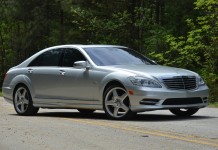For 2011, AMG is introducing its own special version of a new Mercedes-Benz V8 engine that produces more power while getting better fuel economy – an astounding feat, considering that increasing either one usually decreases the other. Replacing the normally aspirated 6.3-liter V8 in the S63 AMG sedan and the CL63 AMG coupe, the new smaller-displacement 5.5-liter V8 features twin turbochargers, direct fuel injection, start/stop technology and multi-spark ignition.
The new AMG twin-turbo V8 produces 536 horsepower and 590 lb.-ft. of torque, while the outgoing engine produced 518 hp and 465 lb.-ft. In particular, the new engine makes 125 additional lb.-ft. of torque, and yet gets 25 percent better fuel economy.
Twin Turbos and Direct Injection
The new engine features twin turbochargers – one for each bank of cylinders. Welded directly to the exhaust manifold, the exhaust-driven turbochargers force intake air into the engine at a pressure of up to 1.0 bar, or about 14 pounds per square inch above normal atmospheric pressure. The engine’s impressively compact layout includes an air-water intercooler nestled in the “V” of the engine – where the intake manifold is located on a conventional V8 engine.
Like its predecessor, the new engine features aluminum cylinder heads, pistons and cylinder block with cast-in Silitec cylinders, as well as a crankshaft, connecting roads and valves made of special forged steel. The AMG V8 has a 10.0-to-1 compression ratio – relatively high for a turbocharged engine. However, pistons crowns are four millimeters thicker to handle the higher combustion pressures, while shorter connecting rods allow existing block dimensions to be retained.
Among the many special AMG touches on the new engine are “pulsation holes” drilled through the internal webs of the cylinder block. While up-and-down movement of the pistons usually pushes air around inside the crankcase and robs power, the pulsation holes allow this internal air pressure to be better equalized between cavities, actually increasing power as a result.
The Third Generation of Mercedes-Benz Direct Injection Systems
The world’s first gasoline engine with direct fuel injection was the 1954 Mercedes-Benz 300SL Gullwing. Since then, the company has pioneered direct injection for several high-efficiency European models, including the 2006 CLS350 CGI, powered by the world’s first gasoline engine with piezo-electric direct injection and spray-guided combustion. This advanced V6 engine achieved 10 percent better fuel economy versus the normal V6 with port injection.
The fuel system in the new bi-turbo V8 represents the third generation of modern Mercedes-Benz gasoline direct injection systems, and the first to be offered in the U.S. market. System pressure of the electronic direct injection system is similar to less precise mechanical injection systems – up to 200 bar or 2,840 psi. The new V8 makes use of industry-leading electronics technology first used on Mercedes-Benz diesels – piezo-electric fuel injectors that spray gasoline directly into the combustion chambers. In the past, nearly all gasoline engines have used indirect port fuel injection.
Crystals are the Heart of the New System
Instead of conventional mechanical injector valves, piezo injectors feature a piezo-ceramic crystalline element that, in microseconds, simply changes shape when electrical current is applied. The blazingly fast piezo injectors make it possible to design very sensitive and precise injection systems, including the ability to program several small injections with each piston stroke. This is especially impressive, considering that engines idle at about 20 strokes per second and 200 strokes every second at high speeds.
The first injection is sprayed into the combustion chamber as the piston is descending on the intake stroke. Depending on speed, load and temperature conditions, another injection or two takes place during the compression up-stroke before ignition, forming a stratified mixture. A fourth injection can stabilize combustion if it’s needed. Among other things, this advanced spray-guided combustion process demonstrates the potential of the internal combustion engine for continued development and refinement.
Multi-Spark Works with Multi-Squirt
Working together with the spray-guided direct injection, a rapid multi-spark ignition system begins combustion with the first spark, but has the capability to recharge and deliver up to three more sparks within a single millisecond, creating a gas plasma with more expansion than conventional ignition. The time lapse between sparks is adjustable, so combustion duration can actually be controlled, resulting in two percent better fuel economy, and a total of four percent improvement in combination with its companion direct fuel injection system.
More Efficient Cam Chain Drive
Mounted on the ends of the intake and exhaust camshafts, the hydraulic camshaft adjusters that vary valve timing are now 35 percent faster, and with a wider range of 40 crankshaft degrees, yet are more than a half inch smaller in height and width.
These smaller valve timing adjusters are made possible by a new cam chain drive system, in which the crankshaft drives an intermediate shaft above the crank. In turn, the intermediate shaft drives two short chains – one for each cylinder bank – that loop around the intake and exhaust camshaft drive sprockets. The new chain drive results in less tension and lower chain dynamics, for even lower friction and less noise.
A fourth chain drives a new variable vane-type oil pump in the bottom of the engine. At low engine speed and load, the oil pump only generates about 28 psi (or two bar) of oil pressure, and nozzles that spray cooling oil on the pistons are off. As engine speed and load increases, oil pressure goes up, and the oil spray nozzles are turned on. In this way, less energy is used when less cooling and lubrication is needed.
Three-Phase Low-Load Cooling System
Even the cooling system is significantly refined in the new engine, beginning with a two-stage flow circuit through the cylinder head. This improved coolant flow results in better heat dissipation, despite lower coolant circuit pressure, so that the water pump uses less engine power.
A three-phase cooling system helps the engine warm up very quickly. When the engine is first started, no coolant is circulating. As the engine warms up, coolant begins to circulate within the engine, but not through the radiator. Only when the coolant temperature reaches 221 degrees Fahrenheit (or 189 degrees under high load), coolant also circulates through the radiator. Coolant circulation through the heating system for the car’s interior is controlled separately.
Start-Stop System with Direct-Start
Whenever the engine is automatically turned off to save fuel, the engine computer decides which piston is in the best position for first ignition. The direct fuel injection and multi-spark systems work with a starter motor to re-start the engine almost instantly. In the future, this new technology may actually be used to start engines without using a conventional starter motor.





